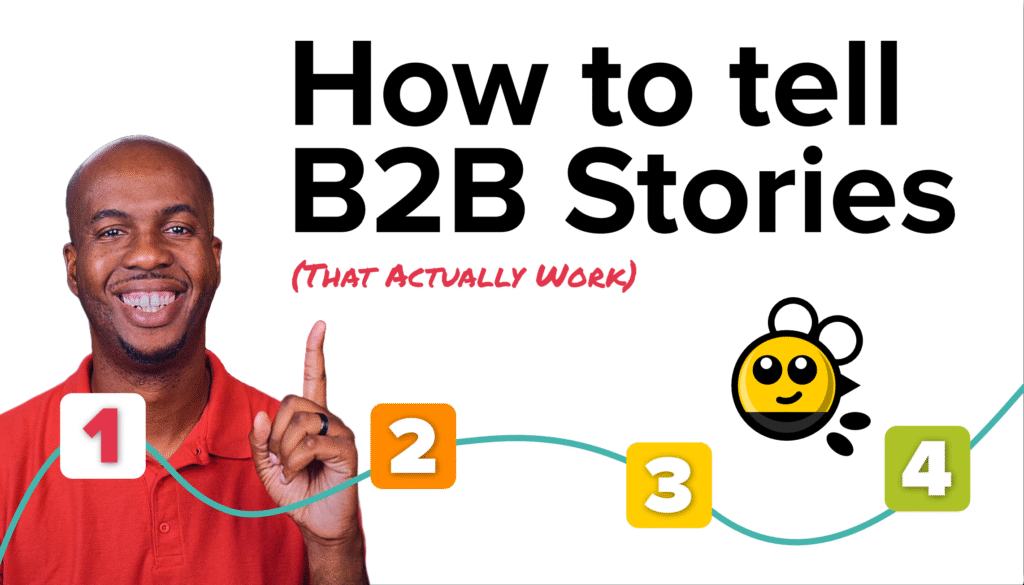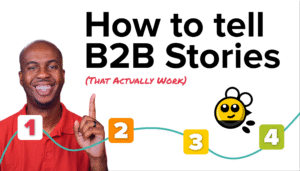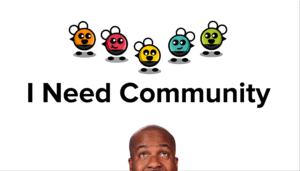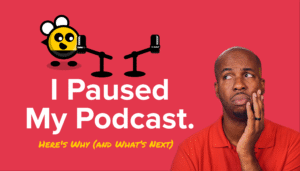Regular storytelling and storytelling for your business is NOT the same.
Today I’m going to give you a 4 step Framework to tell compelling, relatable stories for business because everyone is telling you “tell stories” or “tell better stories” in your content but no one is really showing you how and while you might find some great, even excellent, storytelling books and videos out there, no one is teaching you a simple structure on how to tell stories specifically for your business.
Why is Storytelling for your business important?
Storytelling isn’t a buzzword. Right now, it’s one of the only things that will separate your content from most of the generic, noisy, and sometimes mostly AI generated content out there. Your stories can only be told by you and people looking to do business value that, because the internet and specifically social media, is more fake than ever which makes it difficult to find people you can trust. If done right storytelling is a powerful tool that can help your business where it matters most, building long-term relationships with paying clients and that’s why it should be VERY important to you.
The problem.
First I want to address something.
Most of us avoid telling stories because we don’t really understand what that means. We feel that the term is vague and overused or maybe we don’t think we have any business stories to tell, or maybe we feel that our stories are not very interesting, or maybe we simply don’t know how to tell stories for our business.
Truthfully, I myself avoided talking about storytelling for a long time because even though in my own business we’ve done hundreds of video projects, telling stories on behalf of our clients, we never created a “formal” system for it, but since starting to create my own content I’ve shared so many stories I’ve decided to codify it for myself and others to benefit.
We’ve helped our clients tell stories with video like the one below:
So today I’m going to show you how you can use storytelling in your business Whether you’re an employee, solo operator, or running a small team I’ll teach you the practical framework and examples so you can plug this in right away.
BUT FIRST,
Why is sharing stories important for your career and for business?
Three things we are always fighting for when we market our business, is for people to know us, like us and trust us.
Stories can help you get all of those things.
Stories help us be more relatable so we can introduce ourselves to potential customers and they get to know us. Stories are a good way to share examples and show our personality, so they get to like us. Stories give us the ability to show how we get real results and help people just like them, so they get to trust us.
Storytelling is not a new thing. We’ve been telling stories as a civilisation for thousands of years, but there’s one thing that makes all the difference when you tell stories for business.
What makes a business story different from a regular story?
Normally when we tell a story, we tell it from the first person Point of View or the “I” viewpoint. Think about the last story you shared with your friends. We talk about what happened to us and what matters to us. We talk about how it made us feel and our response to what happened. We are the character that drives the story. We are masters at talking about ourselves.
But theres a fundamental switch when telling business stories.
When you tell stories for business, instead of first person point of view, you should focus on the second person POV or the “YOU” point of view. Which speaks to our potential customer, by focusing the process of our current customer.
First Person Point of View (I): We emphasise ourselves, our business and what we can do.
Second Person Point or View (You):We emphasise the person viewing the content; our potential customer and what we can do for them.
People who are avid readers would know that this is the same technique that authors use to draw the readers into a story. An article on masterclass.com describes it like this:
“Second person point of view uses the pronoun “you” to address the reader. This narrative voice implies that the reader is either the protagonist or a character in the story and the events are happening to them…”
Normally when we tell a story, we are the main character and the focus is on us. What you need to be a successful business storyteller is to flip that. Don’t focus first on what you do, focus on transformation that you helped create in your current customer and how that might also happen for your potential customer.
Here’s the BIG secret:
If you focus on the customer first and you show them how you can help them overcome their problems and how their business can be transformed, then you will still reap the benefits.
USEFUL STORYTELLING FRAMEWORK
(or the 3CT B2B Storytelling Framework, I’m workshopping the name 
You can tell your business stories in these four steps:
CONTEXT → CONFLICT → COLLABORATION → TRANSFORMATION
1 CONTEXT: In film, this is called your establishing shot. This is where your introduce your audience into the environment where the story will take place. It’s the place you make the initial connection.
In business stories, these are the facts that show the state you met your client in. This is to establish who your client was before they started working with you. You give context so that people care. So you want to answer questions like:
- What type of business did they have?
- What type of things were they were doing at the time that they reached out to you?
- What were their numbers in sales or what system are they currently using for business?
You want to state these facts because you want to establish an entry point and foundation for the story so that it’s easier for people to care about what happens to your client later.
2 CONFLICT:Every story needs an enemy, every story need resistance, even business stories. Some might say, especially business stories. Without an enemy, without resistance, there is nothing at stake. There was nothing to lose and if there is nothing to lose, potential customers are not going to make an emotional investment in your story. Without emotion, they are not going to stick around to hear the end.
The context was a bit of logic, a bit of why you might care, but that is not enough to get people to listen to the entire story. The conflictis the thing that gets you invested in the outcome. Especially if your potential customers have the same exact conflict that your current client has. The same way a hero is nothing without an arch nemesis. So your client is nothing without a problem that needs solving. The painful problem your client is experiencing, is their conflict.
Conflict is not about what the client will gain. It’s about what the client stands to lose.
- Are they losing opportunities?
- Are they losing reputation?
- Are they losing time?
- Are they losing money?
- Or will they even lose their business?
Conflict answers the question: “What’s at stake here?”.
Now let’s get into the third part of the framework, collaboration.
3 COLLABORATION: This is my favourite part of all of these steps, because this is the where I (and you) get to work with the client to help them overcome the conflict they are experiencing. This is the part of your business story where the action starts. This is where you get to describe your methods, your services, your products, your frameworks and anything else that you use in order to help your clients. This is where potential clients really get a clear understanding of “What is it like to work with this person / company?” In the collaboration part of the story you can use video to show things like your process and behind the scenes with your clients.
Let’s go onto the final step.
4 TRANSFORMATION: This shows the outcome that working with you has produced, highlighting the contrast between your client’s state BEFORE they worked with you and their state now. If you did your job well, both you and your client will have much to say in this section. It’s a good idea to get video recordings of your actual clients talking about the transformation, (Client testimonials) this is most impactful. In this section you want to focus on FACTS, FIGURES and FEELINGS.
FACTS: How has working with you helped in practical terms? e.g. Before working with (your business name here) we were planning to cut staff, now were are looking to hire 5 new salespeople.
FIGURES: What numbers or data do you have to support these claims? e.g. We were losing $10,000 a month with our old system, but after implementing (Your Business Name here)’s system we are now projected to have a 15% increase in profit this quarter.
FEELINGS: How has this transformed the mental state of the client? e.g. Working with (Your Business Name here) has been incredible, we were stressing out and losing sleep over what to do next, but now we are confident we’ll be able to reach our projections this year.
That’s it, but before we go, let’s summarize:
- Importance of Storytelling: Understand that storytelling can make you distinct in a crowded and noisy internet, helping to build genuine connections and trust with your audience.
- Common Hurdles: Recognize common barriers like feeling stories are vague or not having interesting stories to tell. These are challenges that can be overcome with the right approach.
- Business Storytelling vs. Personal Storytelling: Shift from a first-person (“I”) to a second-person (“you”) perspective in business storytelling. Focus on how your solutions benefit the customer rather than solely describing your business.
- Why Stories Matter: Stories make your business more relatable, likable, and trustworthy. They humanize your brand and showcase real-world results, fostering deeper connections with potential clients.
- Framework Overview: Utilize the 3CT B2B Storytelling Framework: Context, Conflict, Collaboration, Transformation.
- Context: Begin with establishing the initial state of your client or situation. Provide factual background that makes your client’s journey relatable and engaging.
- Conflict: Introduce the challenge or problem your client faced. Emphasize what was at stake and why it mattered, creating emotional investment from your audience.
- Collaboration: Highlight how you collaborated with the client to overcome the conflict. Showcase your methods, services, and the unique value you brought to the table.
- Transformation: Showcase the positive outcomes and transformations achieved through your collaboration. Use factual data, figures, and client testimonials to substantiate the impact of your services.
- Implementation: Apply this framework to tell compelling stories that resonate with your audience, whether you’re a solo entrepreneur or leading a team. Use video to enhance storytelling by showing your process and client interactions
A final note:
Your storytelling still has to fit within the USEFUL Video Structure. We’ll get into that in a future newsletter.

I apologise to the early readers of this newsletter…I was making edits as I was rushing to leave the house this morning, so the first version of this I posted had sooooo many grammatical errors and confusing sentences. 
ALSO…If you’re a professional stuck with video, get your FREE video check up here:https://sendfox.com/lp/mppgqq










